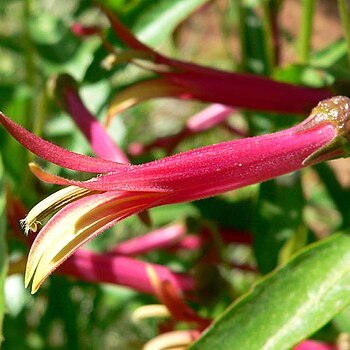Annual or perennial herbs or shrubs. Leaves, simple, exstipulate, alternate, sessile or short-petiolate, pinnately veined and serrate to subentire with the teeth ending in minute callosities. Flowers solitary in the terminal leaf axils or in bracted, terminal racemes, usually inverted, pedicellate, mostly bibracteolate, more or less ascendant at anthesis; corolla usually with a dorsal slit from the apex nearly to the base and often bearing 2 lateral slits (= fenestrae) as well, strongly zygomorphic with 2 upper lobes and 3 lobes comprising the lower lip; filaments usually free from the corolla, connate at least distally into a monodelphous tube, the anthers laterally united into a tube and the pollen released into the central cavity formed by the fused anthers, unequal, the 2 lower anthers shorter, usually with a penicellate tuft of bristles at the tip, the 3 longer anthers partially closing the orifice of the anther tube by their strongly incurved tips. Capsules 1/4 to com-pletely enclosed by the hypanthium, dehiscing loculicidally apically, corolla, stamens and style withering-persistent; seeds, numerous, smooth and shining, pitted or tuberculate.
Herbs, but some species lignified at base, and even some species in Africa and Hawaiian Islands trees and shrubs. Leaves alternate, in 2 rows or spiral. Flowers solitary and axillary, or in terminal racemes, or in panicles of racemes, bisexual [some Australian species dioecious]; bracteoles present or absent. Flowers pedicellate, solitary and axillary or in terminal racemes (rarely secund or corymbose) or panicles. Calyx lobes entire or serrate, persistent, rarely auriculate. Corolla zygomorphic, rarely with a narrow nectar spur; dorsal side typically divided longitudinally to base or nearly so, sometimes laterally fenestrate; limb commonly bilabiate, dorsal lip 2-lobed, ventral lip 3-lobed, or rarely ventrally unilabiate. Stamens connate, enveloping style, exserted from corolla dorsally; all 5 anthers or just ventral pair barbate at apex (rarely all nude). Ovary inferior or semi-inferior, very rarely almost superior, 2-locular; stigma 2-fid; ovules numerous. Fruit an apically 2-valved capsule or a berry. Seeds numerous, oblong or 3-angled, sometimes winged, smooth, foveolate, striate, or verrucose.
Cor irregular, inverted so that the 3-lobed morphological upper lip is on the lower (abaxial) side; cor-tube split (between the 2 lobes of the visually upper lip) to below the middle, commonly nearly to the base, often fenestrate on the sides near the base as well; filaments and anthers connate, the lower 2 anthers shorter than the others and bearded at the tip; ovary 2-locular, with axile placentation; style growing up through the anther-tube and pushing out the pollen; stigma 2-lobed; capsule opening at or near the top; ours fibrous-rooted, mostly single-stemmed herbs with the fls in terminal, bracteate racemes, rarely in the uppermost axils. Most of our spp. perennate by short offsets, a few by rhizomes; L. inflata appears to be annual. 300, widespread.
Mostly annual or perennial herbs, occasionally monocarpic and giant in stature, rarely shrubs. Lvs alternate; cauline lvs sometimes reduced to bracts, toothed or entire; sap sometimes acrid. Infl. a terminal raceme, spike or panicle, sometimes fls solitary. Fls usually ☿. Calyx with short, often globular, tube adnate to ovary. Corolla oblique and 2-lipped; tube split to base on 1 side; limb 2-lipped with upper lip 2-lobed and lower lip 3-lobed. Stamens not epipetalous; filaments free; anthers united into a tube around style, 2 or all of them hairy at tips. Ovary 2-celled; stigma ± 2-lobed. Capsule 2-valved, dehiscing loculicidally. Seeds numerous, minute.
Fls 5-merous, axillary, solitary or in racemes; receptacle adnate to ovary; corolla oblique, split to base at back, upper lip 2-lobed, lower 3-lobed. Staminal tube free from corolla; anthers connate, awn-tipped. Ovary 2-celled, ovules ∞; style filiform, stigma emarginate, often subtended by ring of hairs. Capsule 2-celled, loculicidally dehiscent; seeds minute, ∞. Mostly herbs with alt., us. toothed, simple lvs. Widespread genus with some 250 spp. L. anceps in various forms occurs also in Australia, Tasmania, S. America and S. Africa; the other N.Z. spp. are endemic.


